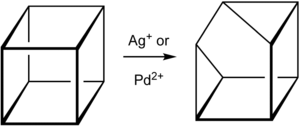Cuneaan
| Cuneaan | ||||
|---|---|---|---|---|
| Structuurformule en molecuulmodel | ||||
 | ||||
Structuurformule van cuneaan | ||||
| Algemeen | ||||
| Molecuulformule | C8H8 | |||
| IUPAC-naam | pentacyclo[3.3.0.0 2,4.03,7.06,8]octaan | |||
| Molmassa | 104,15 g/mol | |||
| SMILES | C12C4C3C1C2C5C3C45 | |||
| InChI | 1S/C8H8/c1-2-5(1)6-3-4(6)8(2)7(1)3/h1-8H | |||
| Wikidata | Q2191837 | |||
| ||||
Cuneaan[1] is een verzadigde koolwaterstof met als brutoformule C8H8. De naam van de verbinding is afgeleid van het Latijnse cuneus, wat wig betekent.[2]
Synthese
Cuneaan kan bereid worden uit cubaan via een metaalgekatalyseerde sigmatrope reactie:[3][4]

Sigmatrope omlegging van cubaan tot cuneaan
Als katalysator kan zilver of palladium aangewend worden. Voor homocubaan (C9H10) en bishomocubaan (C10H12)zijn gelijksoortige reacties beschreven.[5][6]
Structurele eigenschappen
In cuneaan komen drie groepen van equivalente koolstofatomen voor. Deze drie groepen zijn ook aangetoond met behulp van 13C-NMR.[7]
De moleculaire graaf van het koolstofskelet van cuneaan is regulier met niet-equivalente groepenknooppunten. Dit maakt cuneaan tot een belangrijke teststof in de theoretische chemie.[8][9]
Sommige derivaten van cuneaan hebben met vloeibare kristallen vergelijkbare eigenschappen.[10]
- ↑ 2D and 3D Models of Dodecahedrane and Cuneane Assemblies . Gearchiveerd op 4 oktober 2022.
- ↑ R. Criegee, R. Askani. (1968). Octamethylsemibullvalene Angewandte Chemie International Edition. 7 pag.: 537 DOI:10.1002/anie.196805371
- ↑ Michael B. Smith, Jerry March. (2001). GEEN TITEL OPGEGEVEN March’s Advanced Organic Chemistry 5th pag.: 1459 – John Wiley & Sons, Inc. ISBN 0-471-58589-0
- ↑ Philip E. Eaton, Luigi Cassar, Jack Halpern. (1970). Silver(I)- and palladium(II)-catalyzed isomerizations of cubane. Synthesis and characterization of cuneane J. Amer. Chem. Soc.. 92 pag.: 6366 – 6368 DOI:10.1021/ja00724a061
- ↑ Leo A. Paquette, John C. Stowell. (1970). Silver ion catalyzed rearrangements of strained .sigma. bonds. Application to the homocubyl and 1,1'-bishomocubyl systems J. Amer. Chem. Soc.. 92 pag.: 2584 - 2586 DOI:10.1021/ja00711a082
- ↑ W. G. Dauben, M. G. Buzzolini, C. H. Schallhorn, D. L. Whalen, K. J. Palmer. (1970). Thermal and silver ion catalyzed isomerization of the 1,1′-bishomocubane system: preparation of a new C10H10isomer Tetrahedron Letters. 11 pag.: 787 - 790 DOI:10.1016/S0040-4039(01)97830-X
- ↑ H. Guenther, W. Herrig. (1973). Anwendungen der 13C-Resonanz-Spektroskopie, X. 13C,13C-Kopplungskonstanten in Methylencycloalkanen Chemische Berichte. 106 pag.: 3938 – 3950 DOI:10.1002/cber.19731061217
- ↑ M.I. Trofimov, E.A. Smolenskii. (2000). Electronegativity of atoms of ring-containing molecules—NMR spectroscopy data correlations: a description within the framework of topological index approach Russian Chemical Bulletin. 49 pag.: 402 DOI:10.1007/BF02494766
- ↑ M.I. Trofimov, E.A. Smolenskii. (2005). Application of the electronegativity indices of organic molecules to tasks of chemical informatics Russian Chemical Bulletin. 54 pag.: 2235 DOI:10.1007/s11172-006-0105-6
- ↑ Gyula Bényei, István Jalsovszky, Dietrich Demus, Krishna Prasad, Shankar Rao, Anikó Vajda, Antal Jákli, Katalin Fodor‐Csorba. (2006). First liquid crystalline cuneane‐caged derivatives: a structure-property relationship study Liquid Crystals. 33 pag.: 689 - 696 DOI:10.1080/02678290600722940













